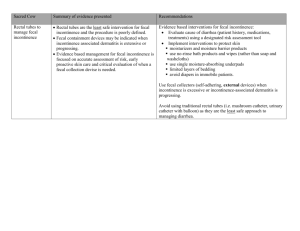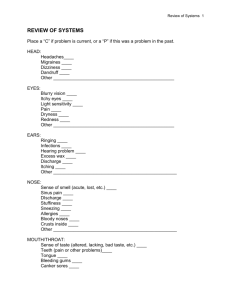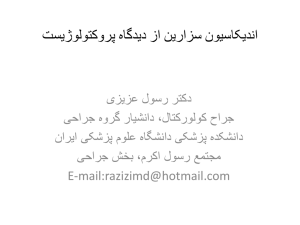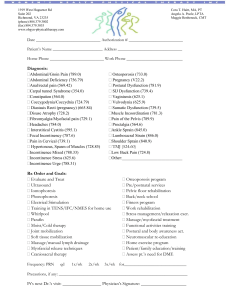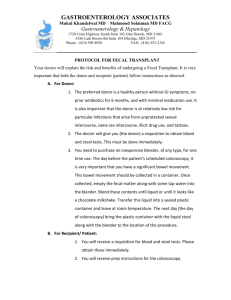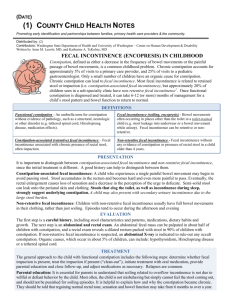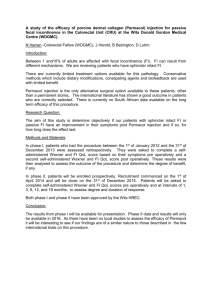Document 14882746
advertisement
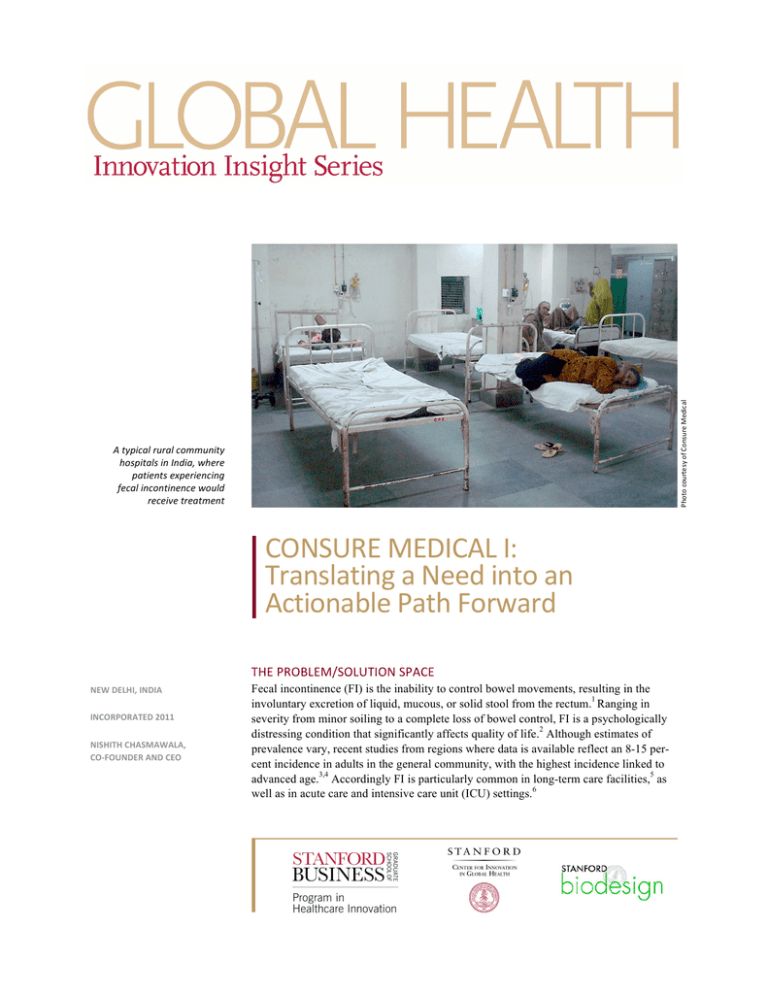
Photo courtesy of Consure Medical A typical rural community hospitals in India, where patients experiencing fecal incontinence would receive treatment CONSURE MEDICAL I: Translating a Need into an Actionable Path Forward THE PROBLEM/SOLUTION SPACE NEW DELHI, INDIA INCORPORATED 2011 NISHITH CHASMAWALA, CO-­‐FOUNDER AND CEO Fecal incontinence (FI) is the inability to control bowel movements, resulting in the involuntary excretion of liquid, mucous, or solid stool from the rectum.1 Ranging in severity from minor soiling to a complete loss of bowel control, FI is a psychologically distressing condition that significantly affects quality of life.2 Although estimates of prevalence vary, recent studies from regions where data is available reflect an 8-15 percent incidence in adults in the general community, with the highest incidence linked to advanced age.3,4 Accordingly FI is particularly common in long-term care facilities,5 as well as in acute care and intensive care unit (ICU) settings.6 Because FI is considered a symptom, not an independent diagnosis, treatment strategies differ depending on the underlying cause(s). In some cases, FI can be improved through surgery, dietary changes, medication, or a program of targeted exercises.7 However, for patients in acute care facilities and other high-dependency settings, FI is managed primarily with absorbent pads and adult diapers, which are time and labor-intensive as well as unpleasant for caregivers to manage. These solutions are also linked to serious complications, including a 22x greater likelihood of developing pressure ulcers,8 and an elevated risk of skin breakdown and infection resulting from prolonged exposure to liquid or solid waste.9 Such outcomes increase the length of hospitalization, add significantly to the cost of care, and increase mortality by more than 7 percent.10 To avoid these problems, indwelling rectal catheters attached to a collection bag are sometimes used to control liquid or semi-liquid stool.11 Yet many caregivers report leakage problems with this approach.12,13 In addition, these solutions cannot be used for formed stool and may be utilized only in medically supervised settings.14 Photo courtesy of Consure Medical ABOUT CONSURE MEDICAL The co-­‐inventors of the technology: Nish Chasmawala, Dr. Sandeep Singh, and Amit Sharma (from left) In 2008, plastics engineer Nish Chasmawala was a fellow in the Stanford-India Biodesign (SIB) Program. One of several partnership programs developed by Stanford Biodesign to train the next generation of global medical technology innovators, SIB is a collaboration between Stanford University, the Indian Institute of Technology Delhi, and the All India Institute of Medical Sciences (AIIMS), in partnership with the Indo-U.S. Science & Technology Forum (IUSSTF). SIB fellows with engineering, medical, and business backgrounds work as a team to examine clinical needs and identify opportunities for medical technology innovation, first at Stanford and then in India. Guided by faculty and real world experts in both countries, SIB fellows seek to address these needs by developing new technologies with the goal of taking these solutions to scale in the Indian market. Chasmawala came to the fellowship with significant medical device experience, having worked for Cordis, Kyphon, and LeMaitre Vascular on medical devices for the U.S., European, and Japanese markets. In describing the origin of Consure, he explained that while participating in a clinical needs-finding exercise at Stanford, one of his classmates had to go back to India to help care for his mother, who had become very ill. When that colleague returned to Stanford, Chasmawala and others tried to distract him from his worries by asking if he had identified any needs while he was away. “And the need that he threw out on the table that day was fecal incontinence,” Chasmawala reported. “It’s pretty embarrassing and nobody talks about it. But it’s also a genuine need, and they couldn’t find any good solutions for it in India. It was worth taking a deeper look.”15 Chasmawala looked into FI management and available treatment options at the Stanford Hospital. “But our real desire was to do something for the Indian market,” he noted. When the team members returned to India, they went through the clinical needs-finding process again. For six weeks, they observed patient care in a variety of medical settings, including a large tertiary care hospital, a brand new, state-of-the-art trauma center, and rural community and public health centers. At the end of the exercise, they had identified CONSURE MEDICAL: TRANSLATING A NEED INTO AN ACTIONABLE PATH FORWARD FEBRUARY 2013 2 300 needs that they could conceivably address. “Still, I was comparing all of those needs against fecal incontinence, thinking, does this measure up? Because it’s got to be something worth pursuing,” Chasmawala said. After completing extensive screening and validation, FI remained at the top of the list of needs. The team members decided to commit themselves to the space, and Chasmawala and SIB partner Amit Sharma co-founded Consure Medical in December of 2008. With grants from the Indian Government and Johnson & Johnson, they began working full-time on the project in March 2009. “We also had a term sheet from a Silicon Valley-based investor, but decided to reject the offer as we were motivated to build an India-based company,” Chasmawala recalled. ONE CHALLENGE: TRANSLATING A NEED INTO AN ACTIONABLE PATH FORWARD Although Chasmawala and Sharma had a broad concept of the need they would address, they quickly discovered that more research was required to thoroughly understand how to make that need actionable. “FI occurs in multiple settings,” stated Chasmawala. “There is a large patient population in ICU and non-ICU medical settings, and in long-term care facilities. And there is an even bigger population of patients with FI living at home. Most of the patients are chronically ill, but some also have acute conditions that make them even more fragile.” This diversity in the patient population meant that there were multiple stakeholders to consider, including doctors, nurses, other professional caregivers, family caregivers and, of course, the patients themselves. The Consure team had to figure out whether all of these stakeholders Even though they had already had the same needs and concerns and, if not, which ones to prioritize as they began to conceptualize solutions. They also had to translate the devoted countless hours to needs, preferences, capabilities, and constraints of the target audience the needs-finding process, into specific design requirements to help guide product development. Even though they had already devoted countless hours to the needsthey realized that their hard finding process, they realized that their hard work was just beginning. work was just beginning. THE SOLUTION: PROGRESSIVELY DETAILED NEEDS FINDING AND THE IDENTIFICATION OF DESIGN REQUIREMENTS To help them make these important decisions, Chasmawala and Sharma sought to immerse themselves even more completely in the problem of FI through another iteration of progressively detailed needs assessment. They spent significant time re-examining each stakeholder segment, talking with representatives about their experiences, and understanding the full context within which these individuals played a role in managing FI, including the challenges, emotions, and potential opportunities. They also stayed in touch with the SIB Fellow who initially suggested focusing on FI, since this individual had firsthand experience and heartfelt empathy for those affected by the condition. Through this deep engagement, they found that the scenario of a family member trying to care for a loved one with FI in the hospital or at home resonated with them most personally. “In rural community hospitals in India, there are usually eight beds in a room with limited ventilation and inadequate waste disposal systems. Family members usually try to form a human shield to do an absorbent pad change and clean the patient. Spending time in these settings created a sense of pathos is us, but also motivated us to develop a solution for these underserved markets,” Chasmawala said. “FI causes as much anxiety and CONSURE MEDICAL: TRANSLATING A NEED INTO AN ACTIONABLE PATH FORWARD FEBRUARY 2013 3 embarrassment for caregivers as for those who have the condition,” he added. Family members caring for loved ones was extremely common in resource-constrained environments such as India, where elder care was more likely to be provided by the family than by nursing homes or other long-term care facilities. Accordingly, the Consure team decided to design a device that could ultimately meet the needs of a motivated family caregiver. “So that was the insight we had: to make a device that was simple enough, easy enough, and safe enough for a motivated family member to use in caring for a loved one with FI,” Chasmawala explained. Photo courtesy of Consure Medical With this target audience top of mind, the team next sought to define the design requirements a solution would have to embody in order to serve this market segment. One significant requirement that the team uncovered early on was the need for the solution to be effective regardless of patient stool consistency. “We learned that there was a considerable amount of caregiver concern around the unpredictability of the stool consistency,” Chasmawala commented. “Given the various medications patients with FI can be on, it is difficult to know whether the stool will be liquid or formed, and this creates anxiety in terms of how to best care for the family member.” The only solutions currently available that could manage both liquid and formed stool were absorbent pads, so the team initially concentrated on a next-generation diaper with multiple layers that could help maintain cleanliness and minimize contact with moisture or other skin irritants. Team members also spent time reviewing available catheter/collection bag solutions. In doing so, they grew convinced that the latter type of treatment could offer superior benefits to patients and caregivers alike if Consure could come up with a better design. The Consure device In addition to being limited to use for liquid or semi-liquid stool, the other challenge with existing indwelling catheters was that they had to be inserted and supervised by medical professionals. To be useful to a motivated family caregiver, Consure would have to design something that could “be used outside an ICU facility or step-down unit, and be inserted without a doctor, imaging, or any pre-insertion examination,” explained Chasmawala. On the plus side, an indwelling catheter solution would potentially be robust enough that doctors, nurses, and other professionals could benefit from it, as well as family caregivers. In medical facilities, one of the earliest issues that the team observed was the reluctance of doctors to participate in managing FI. “There are certain diseases or health situations where that doctor does not want to be involved, and fecal incontinence is one of them. So the doctor delegates or avoids the condition, and the nurse takes on that responsibility,” he described. While the patient was hospitalized, if an indwelling catheter was called for, it was the nurse who had to manually insert it into the rectum. “And this is a significant pain point—it’s unpleasant and the nurses dislike doing it. So we set out to solve that as well, by designing an insertion device that would allow the device to be placed in a clean, hygienic manner,” he related. As Chasmawala and Sharma further considered the needs of its target audience, they realized that, at least in this particular case, cost was not the primary concern. “One of the things we realized was that people—especially family members—don’t make health decisions based solely on cost. So coming up with a cheaper solution was not as important as creating a better solution for the patient that was more effective and easier to use,” Chasmawala recalled. That said, by eliminating the need for imaging, the preCONSURE MEDICAL: TRANSLATING A NEED INTO AN ACTIONABLE PATH FORWARD FEBRUARY 2013 4 insertion exam, and the need for a nurse to insert the device, Consure could build a solution that could not only be implemented by a family member, but was well-suited to cost- and resource-constrained settings such as community hospitals or psychiatric care facilities in smaller cities. Ideally, the device would also mitigate the discomfort of the patients, who see FI care as a humiliating invasion of their privacy. As the requirements for the design of the device began to coalesce, Chasmawala and Sharma found themselves helped significantly by the fact that they were based at AIIMS, where “some of the best doctors in India were working less than 100 meters away.” One of those doctors was Dr. Sandeep Singh, a cardiologist and SIB Fellow from the same class, who became the co-inventor of Consure’s core technology. By providing real-time feedback, the doctors at AIIMS helped the team quickly eliminate bad ideas and narrow down concepts. “People think that passing stool is simple, but if you think about it, gastrointestinal motility is a pretty complex system. We realized that there were multiple sensory pathways at play, and the doctors helped us understand this. Based on their insights, we were able to make mod ifications to our concepts pretty quickly,” Chasmawala noted. “Once we were down to a handful of manageable concepts, we Once we were down to a handful went out and built several prototypes, made mock-ups to test them, and got even more feedback. Without this expert interof manageable concepts, we went action, we would still be meandering our way to the wrong solution or down a longer pathway,” he emphasized. out and built several prototypes, made mock-ups to test them, and got even more feedback. Ultimately, Consure developed an internal catheter that was almost like a short-term implant that could be “inserted and managed by a family member after one or two observations in the hospital,” said Chasmawala. As currently configured, Consure’s device offered numerous advantages over existing FI solutions. “The device is odor-proof, leak proof, and can contain stool regardless of consistency,” he said. “It also has a slick insertion mechanism that is easier on the caregiver and helps preserve the dignity of the patient.” Additionally, the Consure device was the first solution for FI that diverted fecal material without interrupting the normal physiological functioning of the body. “Existing indwelling solutions force the rectum to remain open, which is not its natural position,” Chasmawala explained. In March 2012, Consure executed a Technology Transfer Agreement with the Department of Biotechnology (Government of India) to license the technology for commercialization. This milestone was followed shortly thereafter by a significant funding accomplishment, when the team closed its Series A financing in June of that year. As of February 2013, the company had concluded its product development activities and successfully completed a “first-in-man” safety study. Clinical efficacy testing was in progress in India, and the company was pursuing both FDA and European CE-Mark approvals. Although Consure originally was focused only on the Indian market, the team now believed that the product had global potential. “It is a classic example of reverse innovation,” Chasmawala said. “We didn’t look at the global marketplace; we only looked at hospitals in India, where we saw that doctors and nurses are often absent from this care procedure, and so we made a product for a family member. Now it turns out that the product also has significant potential to alleviate healthcare costs in developed markets.” Accordingly, the team had initiated patent protection in multiple geographies to protect its novel device. CONSURE MEDICAL: TRANSLATING A NEED INTO AN ACTIONABLE PATH FORWARD FEBRUARY 2013 5 Looking ahead, Chasmawala believed the Consure device would first become available in care facilities in select global markets, followed by a future, consumer-centric version designed to serve the even larger population of geriatric patients residing at home. Summarizing the company’s vision, he noted, “FI is a benign condition that creates havoc in care facilities around the world. It is a fast-growing market due to changing demographics and increased awareness of the number of affected patients. We at Consure are motivated to build an emerging market company and positively impact patients’ quality of life. Our internal goal is to touch 100 million patients in 10 years.” NOTES 1 “Fecal Incontinence,” National Digestive Diseases Information Clearinghouse (NDDIC), NIH Publication No. 13-­‐4866, January 18, 2013, http://digestive.niddk.nih.gov/ddiseases/pubs/fecalincontinence/index.aspx (January 28, 2013). 2 Yat-­‐Ching Tong, M.D. “Global View on Urinary and Fecal Incontinence,” Incontinence and Pelvic Floor Dysfunction, 2007; 1(3) 85-­‐88. http://www.tcs.org.tw/issue/Folder/1_3/1-­‐3-­‐85-­‐88.pdf (February 5, 2012). 3 William E. Whitehead, Lori Borrud, Patricia S. Goode, et al., “Fecal Incontinence in U.S. Adults: Epidemiology and Risk Factors,” Gastroenterology, 2009; 137 (2): 512-­‐517 http://www.ncbi.nlm.nih.gov/pmc/articles/PMC2748224/ (January 28, 2013). 4 A.K. Macmillian, A.E. Merrie, R.J. Marshall, et al., “The Prevalence of Fecal Incontinence in Community-­‐ Dwelling Adults; a systematic review of the literature,” Diseases of the Colon and Rectum, August 2004; 47(8): 1341-­‐9 http://www.ncbi.nlm.nih.gov/pubmed/15484348?tool=bestpractice.bmj.com (February 5, 2013). 5 Ibid. 6 D.Z. Bliss, S. Johnson, K. Savik, et al., “Fecal Incontinence in Hospitalized Patients Who Are Acutely Ill,” Nursing Research, 2000 March-­‐April; (49): 101-­‐108, http://www.ncbi.nlm.nih.gov/pubmed/10768587 (January 30, 2013). 7 “Fecal Incontinence,” op. cit. 8 J. Maklebust, M.A. Magnan, “Risk Factors Associated with Having a Pressure Ulcer: a Secondary Data Analysis,” Advances in Skin and Wound Care, November 1994, 7 (6): 25, 27-­‐8, http://www.ncbi.nlm.nih.gov/pubmed/7795863 (February 13, 2013). 9 Judith Wishin, T. James Gallagher, Eileen McCann, “Emerging Options for the Management of Fecal Incontinence in Hospitalized Patients,” Journal of Wound Ostomy and Continence Nursing, January/February 2008: 35 (1) 104-­‐110, http://lcbaxterlibrary.tripod.com/ereserves/PUP/18.pdf (January 30, 2013). 10 Chunliu Zhan, Marlene R. Miller, “Excess Length of Stay, Charges, and Mortality Attributable to Medical Injuries During Hospitalization,” JAMA, October 8, 2003, 290 (14): 1868-­‐74, http://jama.jamanetwork.com/article.aspx?articleid=197442 (February 13, 2013). 11 Ibid. 12 “Fecal Management Systems,” allnurses.com, http://allnurses.com/mic-­‐sicu-­‐nursing/fecal-­‐management-­‐ systems-­‐683998.html (January 30, 2013). 13 “Comparison of Two Indwelling Bowel Catheters on Economic Impact by Number of Bedding and Dressing Changes per Day,” Poster Presentation, Critical Care, 2009, 13 (suppl 1): 146, http://ccforum.com/content/13/S1/P146 (February 13, 2013). 14 Ann Yates, “Managing Faecal Incontinence: A Joint Approach to Guideline Development,” Nursing Times; 107: 12, 12-­‐14, http://www.nursingtimes.net/Journals/2013/01/18/v/f/m/290311Faecal-­‐incontinence-­‐-­‐-­‐a-­‐ joint-­‐approach-­‐to-­‐guideline-­‐development.pdf (January 30, 2013). 15 All quotations from an interview with Nishith Chasmawala conducted by the authors, unless otherwise cited. This research was supported by the National Institutes of Health grant 1 RC4 TW008781-­‐01. Lyn Denend and Stacey McCutcheon prepared this vignette with Professor Stefanos Zenios, Ritu Kamal, Christine Kurihara, and Anurag Mairal as the basis for discussion rather than to illustrate either effective or ineffective handling of a management situation. Copyright © 2012 by the Board of Trustees of the Leland Stanford Junior University. All rights reserved. No part of this publication may be reproduced, stored in a retrieval system, used in a spreadsheet, or transmitted in any form or by any means—electronic, mechanical, photocopying, recording, or otherwise—without the permission of the Stanford Graduate School of Business.
